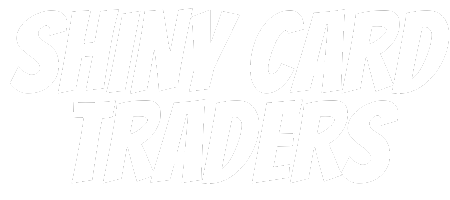Collection: GRADED POKEMON CARDS
Enhance your TCG collection with some of the best graded Pokemon cards you will find. Whether you are after a Charizard or a Pikachu, a Secret rare or an Alternate Art, our graded Pokemon collection is the place for you.
-
ARCEUS & DIALGA & PALKIA GX 002/019 PSA 9 POKEMON CHINESE CSMA ALTERNATE ART
Regular price $100.00 AUDRegular priceUnit price / per -
STARAPTOR LV.X 147/147 PSA 8 POKEMON SUPREME VICTORS HOLO RARE
Regular price $150.00 AUDRegular priceUnit price / per -
MORGAN 157/150 PSA 10 POKEMON JAPANESE ULTRA SHINY GX FULL ART
Regular price $130.00 AUDRegular priceUnit price / per -
MAGNETON 159 PSA 9 POKEMON CENTER ETB PROMO
Regular price $100.00 AUDRegular priceUnit price / per -
ACREUS VSTAR 184/172 PSA 10 POKEMON BRILLIANT STARS SECRET RARE
Regular price $90.00 AUDRegular priceUnit price / per -
SINGLE STRIKE URSHIFU V TG18/TG30 PSA 10 POKEMON BRILLIANT STARS TRAINER GALLERY
Regular price $90.00 AUDRegular priceUnit price / per -
MUDSDALE 175/162 PSA 10 POKEMON TEMPORAL FORCES ILLUSTRATION RARE
Regular price $160.00 AUDRegular priceUnit price / per -
SCIZOR VMAX 193/189 PSA 10 POKEMON DARKNESS ABLAZE SECRET RARE
Regular price $100.00 AUDRegular priceUnit price / per -
WAROTRLE 171/165 PSA 10 POKEMON JAPANESE SV2A ART RARE
Regular price $105.00 AUDRegular priceUnit price / per -
SCIZOR V 118/189 PSA 10 POKEMON DARKNESS ABLAZE ULTRA RARE
Regular price $80.00 AUDRegular priceUnit price / per -
WO-CHIEN EX 257/193 PSA 10 POKEMON PALDEA EVOLVED SPECIAL ILLUSTRATION RARE
Regular price $150.00 AUDRegular priceUnit price / per -
MEGA LOPUNNY & JIGGLYPUFF GX 261/236 PSA 9 POKEMON COSMIC ECLIPSE SECRET RARE
Regular price $135.00 AUDRegular priceUnit price / per -
DARKRAI VSTAR GG50/GG70 PSA 9 POKEMON CROWN ZENITH GALARIAN GALLERY
Regular price $100.00 AUDRegular priceUnit price / per -
BLASTOISE EX 186/165 PSA 10 POKEMON JAPANESE SV2A SUPER RARE
Regular price $85.00 AUDRegular priceUnit price / per -
MEW EX 195 PSA 10 POKEMON JAPANESE SV2A SUPER RARE
Regular price $105.00 AUDRegular priceUnit price / per -
HISUIAN SAMUROTT V GG51/GG70 PSA 10 POKEMON CROWN ZENITH GALARIAN GALLERY
Regular price $130.00 AUDRegular priceUnit price / per -
N'S ZOROARK 127/100 PSA 10 POKEMON JAPANESE SV9 SPECIAL ART RARE
Regular price $150.00 AUDRegular priceUnit price / per -
IONO'S KILOWATTREL 163/159 PSA 10 POKEMON JOURNEY TOGETHER ILLUSTRATION RARE
Regular price $90.00 AUDRegular priceUnit price / per -
POKE KID 197/190 PSA 10 POKEMON JAPANESE SHINY STAR V FULL ART
Regular price $115.00 AUDRegular priceUnit price / per -
INFERNAPE 116 PSA 9 POKEMON TWILIGHT MASQUERADE STAFF PROMO
Regular price $100.00 AUDRegular priceUnit price / per
FAQs
Why Should YOU Buy Graded Pokemon Cards
Buying graded Pokémon cards ensures authenticity, protects the card's condition, and provides an official assessment of its value, condition and rarity, making it a secure investment for collectors and resellers. Graded cards often retain or increase in market value. Each card is given a condition score 1-10 clearly stated on the label of every card. As seen in the high definition scans provided on each product page
Want to Sell Pokemon Cards?
If you have a Pokemon Card collection that you are looking to sell feel free to reach out to us here via email or on any of our social media accounts. Click Here
What is the Pokemon TCG?
The Pokémon Trading Card Game (TCG) is a collectible card game where players build decks using Pokémon cards to battle opponents. Each card represents a Pokémon, item, or move, and players use strategy to defeat their opponent by knocking out their Pokémon.
Are all the Pokemon Cards you sell authentic and are they new or pre-owned?
Every single card that Shiny Card Traders lists and sells is 100% authentic.
As for the condition of all cards in our store they are all "used/pre-owned" products. Nothing we sell in our store is a new/sealed product that comes direct from The Pokemon Company International or Bandai. We Grade all our cards with Reputable grading copanies which again confirmes authenticity and grades each card on a condition scale of 1-10, 10 being the highest condition and 1 being the poorest. These card grades are labelled on the cards, in the title of each product and in the products description to ensure you always purchase the card in the exact condition you are looking for. If you have further questions on this grading scale or about the condition of prodcts feel free to reach out to us via the contact us page.








































